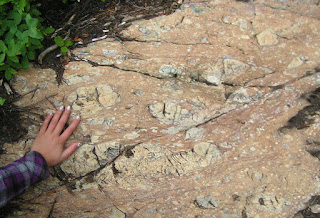So last weekend I went to my first
Pacific Northwest NAGT meeting. The meeting is a collection of mostly 2-year geology teachers who spend 4 days travelling around the area and one day of actual meetings. Because this years meeting was located at
Malheur Field Station in Southeastern Oregon, the first day of the meeting was spent getting there. As many of the participants (and the meeting host) were from the coast area they started near Salem and had a field trip driving to MF, while I took the more direct routes south on 395.
MFS is located northwest of the Steens Mountains on the border between the Basin and Range and the high volcanic plateau of Central Oregon. Although the Steens are an archtypical fault block mountain range, most of the features of the trip focused on Volcanic and Thermal features of the area. The Google map screen shot below shows some of the features we stopped to look at, with red balloons the stops that I will post about in this and the next couple of posts.
One of the first stops on Thursday served a dual purpose. The cap rocks shown below are Devine Canyon Tuff, and there is normal faulting down slope (north) that identifies the Brothers Fault. The Brothers fault at the surface is normal faults, but in general it is a strike slip fault that is the boundary between the relatively stationary Lava High Plains, and the (westward) extension of the Basin and Range to the south.
At this stop there was also a road cut through the tuff which afforded an up close look of the Devine Canyon Tuff. The Devine Canyon Tuff is one of four large welded tuffs in the area: The Rattlesnake (~7.02 Ma), Prater Creek (8.5 Ma), Devine Canyon Tuff (~9.7 Ma), and Dinner Creek (~15.5 Ma). The Devine Canyon Tuff eruptive center was ~20 miles northeast of MFS (~15 miles SE of Burns, OR) covered an area of 18,600 km2 (195,000 k3)to a fairly uniform thickness of about 30m. Because of its size, the Devine Canyon Tuff (and the Rattlesnake Tuff) is a good geologic markers throughout SE Oregon.
On Thursday we also drove north of Burns to look at the Rattlesnake welded Tuff (235,000 km3 with an eruptive center (~50 miles NW of MFS), and where the Dinner Creek Welded Tuff contacted the Mesozoic aged accreted terrain that makes up of much of Oregon (but is mostly covered by Tertiary Volcanics)
On Friday we set out for a ~250 mile circumnavigation of the Steens Mountains. The east face of the Steens is steep exposures of Steens Basalt, and older layers. This vantage point is from the NE looking down Pleistocene Lake Bed at the base of the Range
![]()
Further along, we stopped at Mickey Hot Springs, a series of thermal pools that are being investigated for their potential to produce commerciall scaled geothermal energy. There were a series of hotsprings and abandoned vents in the area. The stricking thing to me though was the overall lack of thermal deposition. There was some sinter, and some algal mats that had lithified, but the area was very low in carbonate deposites that are often associated with thermal areas; in fact the water at the hot springs is fairly low in any dissolved ion content, which is part of what makes it attractive as a geothermal resource. Lastly, because the source of the hot water is not magma (it is hypothesized to be fault driven) so the thermal area had almost no SO2 and the associated sulfur smell. All in all it was a pleasant place to lunch.

 On the left is a picture of my favorite waterfall. On the right is a picture of me in a cave with a "well" on the ceiling.
On the left is a picture of my favorite waterfall. On the right is a picture of me in a cave with a "well" on the ceiling. 


 After we stayed in Newport for awhile we went to Crater Lake. We didn't do much at Crater Lake because it had been a long week and everybody wanted to get home but we did get to see these cool geologic
After we stayed in Newport for awhile we went to Crater Lake. We didn't do much at Crater Lake because it had been a long week and everybody wanted to get home but we did get to see these cool geologic  structures. I don't remember the exact name. I do remember however that inside these is just air they are hollow.
structures. I don't remember the exact name. I do remember however that inside these is just air they are hollow.

























 After people got to feel that we took out an eyeball. When I got to hold the eye I observed that it was hard and not as soft as the intestines or stomach. Which surprised me because I always thought an eye ball was softer than that.
After people got to feel that we took out an eyeball. When I got to hold the eye I observed that it was hard and not as soft as the intestines or stomach. Which surprised me because I always thought an eye ball was softer than that.
